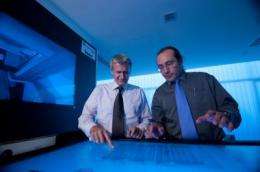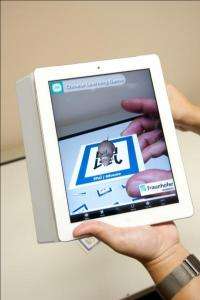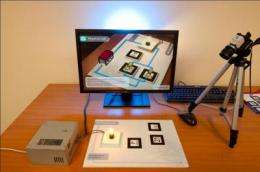NTU unveils newest 3-D technologies for real-world applications

Point your mobile phone camera at a building and it will display the building's history, elaborate on its architecture and even highlight dignitaries who have visited it before.
With this function, mobile phones will not only become a virtual guide for tourists but also able to play a major role in facilitating mobile e-learning.
This augmented reality mobile application is just one of the many prototypes unveiled by one of Europe's largest research organisation, which has a centre here in partnership with Nanyang Technological University (NTU).
The centre, known as the Fraunhofer Interactive Digital Media (IDM) @ NTU showcased the prototypes at its official opening today.
At the opening, joint PhD-Programmes with two leading European universities known for their strengths in engineering and computer science were also launched. This joint doctorate in visual computing is the first of such to be offered in Singapore.
NTU will be partnering Graz University of Technology, Austria, and Technische Universität Darmstadt, Germany, and both programmes are expected to have its first batch of students by January 2012.
This is the first time TU Graz is partnering an Asian university to offer a joint PhD programme and for TU Darmstadt it is its first joint PhD programme with a Singapore university.
The Fraunhofer IDM@NTU is a collaboration between NTU and Fraunhofer. Fraunhofer is Europe's largest application-oriented research organisation, which has more than 80 research units and employs over 18,000 engineers and researchers worldwide.
The $14 million joint research centre is Fraunhofer's first interactive digital media research institute outside of Europe, and is co-funded over five years by NTU, Fraunhofer and the IDM Programme Office hosted by the Media Development Authority of Singapore.
Apart from the augmented reality mobile phone, three other projects were also showcased at the event, including a multi-touch virtual reality table which enables, for example, multiple users to control floor plans on the touch screen and navigate a virtual 3D construct of the building displayed on another screen.

Not only can it display buildings, it can also be programmed to visualise and illustrate the workings of a small biological constructs such as proteins and other micro organisms.
The research centre has also developed a virtual augmented Chinese learning programme which allows Chinese characters that are placed under a camera to display a 3D image of an object. The characters can also be shuffled to form words that will also be illustrated by a virtual object.
Another learning aid showcased was the Augmented Physics Laboratory. This application allows users to build a virtual electric circuit, which causes a light bulb to glow brighter, dimmer, or even to flicker, depending on its design.
This enables students to have real-time experimentation with different electronic components without the danger of overloading electrical components.
Professor Freddy Boey, Provost-Designate of NTU, said the Fraunhofer IDM@NTU centre will bring the best digital media talents in Singapore and Europe together to develop cutting edge innovations to solve real-world problems.
"We are confident that the centre will continue to develop breakthrough innovations in the digital space, especially with Fraunhofer's strong track record in application-driven research for large-scale commercial use. Such breakthroughs are expected to have wide ranging practical applications including engineering and bio-sciences, education, tourism, culture and more," Professor Boey said.
He added that the centre's working prototypes, which have taken a year to develop, is expected to have huge commercialisation potential.
New Media is also one of the five peaks of excellence identified by NTU, a strategic plan which would develop it into a great global university by 2015. These peaks of excellence leverage on NTU's cross-disciplinary strengths and comprehensive offerings. The other four include sustainability, healthcare, the best of the East and West, and innovation.
Adjunct Associate Professor Wolfgang Mueller-Wittig, the co-director of Fraunhofer IDM@NTU, said he has already received various requests from companies and research organisations in Germany asking for guidance on how to set up a similar research centre here.

"We are pioneers, and the centre acts as a blueprint for other universities and organisations to have similar collaborations in Singapore and to tap on the resources here," he said.
Prof. Dr. Dieter W. Fellner, Director, Fraunhofer IGD said the cooperation between NTU, TU Darmstadt, TU Graz and Fraunhofer is a significant step for the development of interactive digital media worldwide.
"The bundling of our research capabilities and the continuous collaboration of our scientists and researchers is a guarantee of success. The Asian and European industry will benefit equally from this," he added.
Mr Michael Yap, Executive Director of IDM Programme Office, Media Development Authority said: "The melding of talents from the two world-class institutions will result in innovative projects that will add depth to Singapore's IDM R&D capabilities,"
"The centre will also help to attract international companies to conduct exciting IDM projects in Singapore, making the country a preferred location for IDM R&D."
Since the centre began operations in June last year, experts at Fraunhofer IDM@NTU have been working together with Fraunhofer Institute for Computer Graphics Research IGD, which has three other centres in Germany and Austria, on the promotion of interactive and digital media research, as well as the commercialisation of IDM innovations.
Apart from projects focusing on virtual reality and augmented reality, the centre will also work on research areas of interest related to current requirements of the market and the economy, such as computer graphics and computer vision. It will also be working with renowned industry giants such as Lufthansa Systems, DPS Engineering, Royce-Rolls and Microvision.
Joint PhD launched
Under the joint doctorate programme, graduate researchers can go to Austria or Germany for at least a year to do their thesis and research at the Fraunhofer institutes there and vice versa.
As a start, a total of 20 scholarships will be given to promising PhD students - 10 from NTU and another 10 from the universities in Germany and Austria.
The agreement was signed by Professor Freddy Boey, Professor Hans Sünkel, President TU Graz, Professor Dieter W. Fellner, Director of Fraunhofer IGD, on behalf of Professor Hans Jürgen Prömel, President TU Darmstadt, and witnessed by His Excellency Mr Jörg Ranau, German Ambassador to Singapore.
Provided by Nanyang Technological University

















